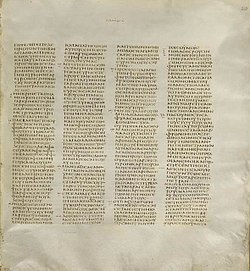Matthew 7
| Matthew 7 | |
|---|---|
 Matthew 6:32-7:27 on Codex Sinaiticus (AD 330–360). | |
| Book | Gospel of Matthew |
| Category | Gospel |
| Christian Bible part | New Testament |
| Order in the Christian part | 1 |
Matthew 7 is the seventh chapter of the Gospel of Matthew in the New Testament. This chapter is the last of the three chapters which comprise the Sermon on the Mount.
Text
The original text was written in Koine Greek. This chapter is divided into 29 verses.
Textual witnesses
Some early manuscripts containing the text of this chapter are:[a]
- Codex Vaticanus (~325–350; complete)
- Codex Sinaiticus (~330–360; complete)
- Codex Washingtonianus (~400)
- Codex Ephraemi Rescriptus (~450; extant verses 6-29)
Verses
- Matthew 7:1
- Matthew 7:2
- Matthew 7:3
- Matthew 7:4
- Matthew 7:5
- Matthew 7:6
- Matthew 7:7
- Matthew 7:8
- Matthew 7:9
- Matthew 7:10
- Matthew 7:11
- Matthew 7:12
- Matthew 7:13
- Matthew 7:14
- Matthew 7:15
- Matthew 7:16
- Matthew 7:17
- Matthew 7:18
- Matthew 7:19
- Matthew 7:20
- Matthew 7:21
- Matthew 7:22
- Matthew 7:23
- Matthew 7:24
- Matthew 7:25
- Matthew 7:26
- Matthew 7:27
- Matthew 7:28
- Matthew 7:29

Analysis
In John Wesley's analysis of the Sermon on the Mount, chapter five outlines "the sum of all true religion", allowing chapter six to detail "rules for that right intention which we are to preserve in all our outward actions, unmixed with worldly desires or anxious cares for even the necessaries of life" and this chapter to provide "cautions against the main hinderances of religion".[1] Within the chapter there are several themes, with verses 1–12 dealing with judging and discernment.[2] Verses 3-5 relate a proverbial saying on the Mote and the Beam, which has a parallel in Luke 6:37-42.[3] At Matthew 7:7 Jesus returns to the subject of prayer, promising that God will respond to prayer. Verses 7:13 and 14 contain the analogy of the broad and narrow roads, a warning of the ease of slipping into damnation. Verse 7:15 continues the warnings about judgment and adds a caution about false prophets[4][5][6] by repeating some of the language used by John the Baptist in chapter 3.
The chapter ends with the parable of the wise and the foolish builders in Matthew 7:24–27, which has a parallel in Luke 6:46–49.
According to theologian Edward Plumptre, in comparison with the preceding chapters, "this [chapter] deals chiefly with the temptations incident to the more advanced stages of [Christian] life when lower forms of evil have been overcome – with the temper that judges others, the self-deceit of unconscious hypocrisy, the danger of unreality".[7]
Explanatory notes
- ^ The extant Codex Alexandrinus and Codex Bezae do not contain this chapter due to lacunae.
Citations
- ^ Wesley, J., Sermon 21, Upon Our Lord's Sermon on the Mount: Discourse One, accessed 10 August 2019
- ^ Talbert, Charles H. Matthew. ISBN 0-8010-3192-3. pp. 91–95.
- ^ Steven L. Cox, Kendell H. Easley (2007). Harmony of the Gospels. ISBN 0-8054-9444-8. p. 72.
- ^ Aune, David E. (1983). "The Prophecies of Jesus: Unmasking False Prophets". Prophecy in Early Christianity and the Ancient Mediterranean World. Grand Rapids, Michigan: Wm. B. Eerdmans. pp. 222–229. ISBN 978-0-8028-0635-2. OCLC 9555379.
- ^ Chae, Young S. (2006). "Matthew 7:15: False Prophets in Sheep's Clothing". Jesus as the Eschatological Davidic Shepherd: Studies in the Old Testament, Second Temple Judaism, and in the Gospel of Matthew. Wissenschaftliche Untersuchungen zum Neuen Testament 2. Reihe. Vol. 216. Tübingen: Mohr Siebeck. pp. 234–236. ISBN 978-3-16-148876-4. ISSN 0340-9570.
- ^ France, Richard T. (2007). "Scene 2: False Prophets". The Gospel of Matthew. Grand Rapids, Michigan and Cambridge, U.K.: Wm. B. Eerdmans. pp. 289–291. ISBN 978-0-8028-2501-8. LCCN 2007013488.
- ^ Plumptre, E. H. (1905), Matthew 7, in Ellicott's Commentary for English Readers, accessed 17 December 2016
External links
- Matthew 7, King James Bible at Wikisource
- English Translation with Parallel Latin Vulgate
- Online Bible at GospelHall.org (ESV, KJV, Darby, American Standard Version, Bible in Basic English)
- Multiple bible versions at BibleGateway.com (NKJV, NIV, NRSV etc.)
